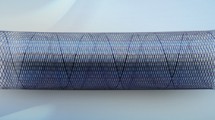Abstract
We report a new variation of the well-established experimental arteriovenous malformation (AVM) model in swine. To provide high flow through the rete mirabile (nidus, RM) and thereby to reduce the rate of spontaneous thrombosis of the AVM, we performed an end-to-end anastomosis of the left common carotid artery (CCA) and the external jugular vein (EJV) microsurgically in three micropigs. After 1 and 4 months the animals underwent angiograms of the CCA and vertebral artery (VA). In all cases the diversion of the blood through the RM was patent, up to the 4 months follow-up. We observed an arteriovenous fistula (arteriovenous pseudomalformation, pAVF) between the VA and the EJV in each case at both 1 and 4 months. This modification of the well-known AVM model in the micropig could be used to monitor long-term changes after embolisation, avoiding the naturally high rate of spontaneous thrombosis. This two-in-one model is thus well suited for preclinical testing of embolic materials.
Similar content being viewed by others
Author information
Authors and Affiliations
Additional information
Received: 2 December 1999 Accepted: 31 August 2000
Rights and permissions
About this article
Cite this article
Klisch, J., Requejo, F., Yin, L. et al. The two-in-one model: a new variation of the arteriovenous malformation model in swine. Neuroradiology 43, 393–397 (2001). https://doi.org/10.1007/s002340000424
Issue Date:
DOI: https://doi.org/10.1007/s002340000424




